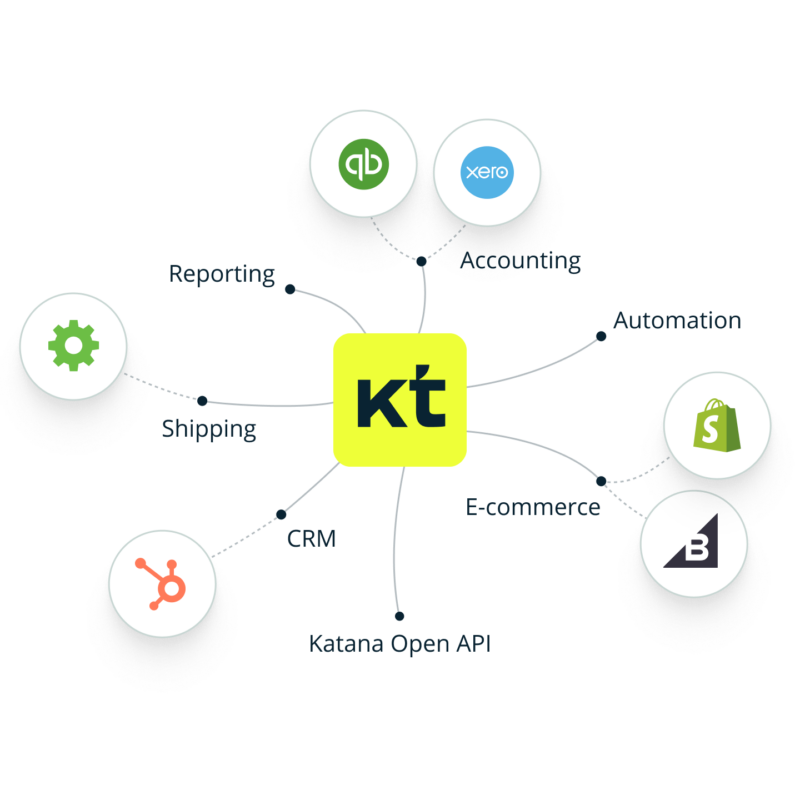Expanding your reach: Multichannel selling
Multi channel selling is more important than ever if you want to reach potential customers. We’ve investigated what it is and how manufacturers can use it.

Henry Kivimaa

Multichannel selling has emerged as a key strategy for businesses seeking to maximize their reach in the digital era. This approach has gained popularity due to the affordability and accessibility of online trading. This article explores the concept of multichannel selling and offers insights into how businesses across various industries can effectively implement this strategy.
Gone are the days when businesses had to rely solely on intermediaries such as retailers and wholesalers to get their products to the consumer market. This traditional path often meant facing hefty fees and restrictive agreements imposed by these middlemen, including consignment inventory arrangements that could leave products languishing unsold on shelves, only to be returned at the seller’s expense once the agreement expired.
Thanks to the advent of multichannel selling, businesses now have the opportunity to directly reach their customers, bypassing traditional third-party channels. This method allows businesses to leverage both physical storefronts and an array of online platforms, making it possible to engage with a broader audience without necessarily maintaining a physical retail presence.
The rise of e-commerce has significantly lowered the barriers to entry for selling online, offering an economical way to expand market reach.
However, adopting a multichannel approach means businesses must now navigate the complexities of managing production, sales, and marketing across multiple channels simultaneously. The responsibility of directly interacting with customers, handling logistics, and executing a cohesive marketing strategy falls squarely on the seller, presenting both challenges and opportunities.
This guide provides valuable insights and strategies to help businesses from all sectors understand how to leverage this model to their advantage. Whether you’re a seasoned player or new to the digital marketplace, understanding multichannel selling is crucial for tapping into new customer segments and driving growth.
What is multichannel selling?
Multichannel selling is a comprehensive strategy that enables businesses to distribute their products or services across a variety of platforms, thereby maximizing their market presence and accessibility to different consumer segments. By adopting this approach, companies can leverage the unique strengths of each channel, such as online marketplaces, social media platforms, their own e-commerce websites, and physical retail locations, to cater to the diverse shopping preferences of their customer base.
This method is particularly effective in enhancing brand visibility and engagement by meeting customers on their preferred platforms, thereby facilitating easier access to products and services.
Additionally, it helps businesses diversify their sales strategies, reduce dependency on a single channel, and potentially increase resilience against market fluctuations. Through multichannel selling, businesses aim to create multiple touchpoints with customers, enriching the customer journey and ultimately driving sales growth by tapping into various consumer pools across the digital and physical retail landscapes
Omnichannel vs. multichannel selling
These terms can often be used interchangeably, but there is a difference:
- Multichannel selling — Using various independent channels, such as online stores, marketplaces, and physical locations, to reach and sell to customers, maximizing reach and sales opportunities.
- Omnichannel selling — Integrates these diverse channels to provide a seamless and consistent customer experience, ensuring customers can switch between channels effortlessly while maintaining continuity in their shopping experience.
What are the different sales channels?
When asked to name different sales channels, people usually think of brick-and-mortar shops, online stores, and perhaps telemarketers. In reality, the list is a lot longer than that, so let’s take a look at the options available.
Online marketplaces
Platforms like Amazon, eBay, Etsy, and Alibaba serve as third-party marketplaces where businesses can reach a vast audience. They are instrumental in increasing visibility and sales due to their high traffic.
E-commerce
This encompasses selling through proprietary online stores using platforms such as Shopify, WooCommerce, or BigCommerce. E-commerce gives businesses control over branding, customer experience, and data while tapping into the convenience of online shopping.
Social media
Platforms like Instagram, Facebook, and Pinterest are not only marketing tools but also serve as direct sales channels through integrated shopping features, allowing businesses to reach customers in their social media feeds.
Physical retail
This includes traditional brick-and-mortar stores and pop-up shops, offering a tangible shopping experience and personal customer service. Retail also encompasses automated retail, like vending machines or self-service stores, providing an unmanned, convenient shopping option.
B2B channels
Businesses selling directly to other companies through wholesale, distributor networks, or dedicated B2B e-commerce platforms. This also includes value-added resellers who enhance a product before selling it and original equipment manufacturers (OEM) that sell components to be used in another company’s final product.
Mobile apps
Creating custom applications enables businesses to offer exclusive deals, enhance customer loyalty, and provide a streamlined shopping experience directly on consumers’ mobile devices.
Personal selling and sales outsourcing
Direct engagement with customers through a sales team or by outsourcing this function to a third-party sales force. This approach is common in B2B settings where personal relationships drive sales.
Resellers and white label
Resellers or drop shippers buy products to sell them on, while white-label products are sold under another company’s brand, allowing businesses to expand their reach without managing production.
Direct marketing
Reaching out to potential customers directly through door-to-door sales, telephone calls, or email campaigns, offering a direct line of communication and sales.
Wholesale and import/export
Wholesalers distribute products in bulk to retailers and resellers, whereas import/export agents handle international distribution, specializing in bringing products into a country or exporting them abroad.
Agents
These are commission-based representatives authorized to negotiate and complete sales on behalf of your business, providing a personalized approach to reaching customers.
The key to successful multichannel selling lies in understanding the unique advantages and challenges of each channel, maintaining a consistent brand experience across all platforms, and effectively managing inventory and logistics to meet demand. This strategy not only increases the points of sale but also leverages the strengths of each channel to enhance customer satisfaction, boost sales, and build a more resilient business.

See Katana in action
Streamline your multichannel inventory management with cloud inventory platform that unifies all your services, so you can manage your entire business from centralized intuitive platform.
Multichannel selling advantages and disadvantages
We’ve already mentioned some of the advantages, but let’s take a more in-depth look at them, and while we’re at it, let’s also go over the disadvantages you’d need to prepare yourself for if looking to expand beyond one sales channel. Multichannel selling, while offering numerous opportunities for growth and customer engagement, also presents challenges that businesses must navigate carefully.
Multichannel sales advantages
- Increased reach and customer base — Multichannel selling allows businesses to tap into various customer segments across different demographics and geographic locations. This expansion leads to a broader customer base and potentially higher sales volume, as it makes products or services available through channels preferred by different groups of consumers.
- Enhanced customer experience — Offering multiple channels for customers to interact with your brand means they can choose the most convenient option, whether shopping online, visiting a physical store, or engaging through social media. This flexibility can significantly enhance customer satisfaction and loyalty, as it caters to the diverse preferences of today’s consumers.
- Diversification of revenue streams — Relying solely on one sales channel can be risky, especially if that channel experiences a downturn. Fuelled by COVID, retail e-commerce saw a 32% jump from 2019 to 2020 as a percentage of total global retail sales.¹ Multichannel selling diversifies your revenue streams, making your business more resilient to changes in market conditions or specific channel-related issues.
- Better data and insights — Operating across multiple channels provides a wealth of data on customer behaviors, preferences, and purchasing patterns. This information is invaluable for tailoring marketing strategies, developing products, and managing inventory more effectively.
- Increased sales and revenue — By making your products or services accessible in various ways, you’re likely to see an increase in sales. It also allows you to benefit from multichannel cross-selling, leading to higher average order values.
- Competitive advantage — A multichannel strategy can set your business apart from competitors who may not have as broad a presence. This advantage is particularly significant in crowded markets, where differentiation is key to attracting and retaining customers.
- Flexibility and scalability — Multichannel selling provides the flexibility to experiment with and scale operations across different markets without significant investment in physical infrastructure. This aspect is especially beneficial for smaller businesses aiming for growth.
- Improved brand awareness — Being visible across multiple platforms increases brand exposure, helping to build recognition and trust among potential customers. This greater visibility can enhance marketing efforts and strengthen your brand’s identity.
But it’s not a magic bullet, there are some challenges you need to face to reap the benefits.
Multichannel sales disadvantages
- Increased complexity — Multichannel management can get quite complex the more channels you add. Companies must navigate different platform requirements, manage integration issues, and ensure consistent inventory tracking, which can be daunting tasks.
- Higher costs — Engaging in multichannel selling often results in increased operational expenses, including platform fees, marketing costs, and logistics. These expenses require careful management to ensure profitability.
- Consistency challenges — Ensuring a unified brand image and customer experience across all channels can be challenging. Each channel may cater to a unique audience and require a distinct engagement strategy, demanding considerable effort to maintain consistency.
- Resource allocation — Effectively distributing resources across multiple channels can be difficult. There’s a risk that focusing too broadly may dilute efforts and impact performance negatively in specific areas.
- Data overload and analysis — Managing and making sense of the vast amount of data generated from multiple channels can be overwhelming. Businesses need robust inventory systems and expertise to effectively harness this information for strategic decision-making.
- Customer service challenges — Providing consistent, high-quality customer service across all channels is crucial but challenging. Customers expect prompt and efficient service, regardless of how they choose to interact with your business.
- Inventory management — Coordinating inventory across multiple sales channels to avoid stockouts or overstock situations adds another layer of complexity. Effective multichannel inventory management is critical to fulfill customer orders promptly and efficiently.
Managing multichannel inventory
Multichannel management can be complex, but with the right strategies, businesses can streamline their operations, reduce errors, and ensure customer satisfaction. Here are 6 most impactful tips for managing multichannel inventory:
1. Use centralized inventory management software
Implement a centralized inventory management system that integrates with all your sales channels. This software should automatically update inventory levels in real time across all platforms whenever a sale is made, a return is processed, or new stock is added. This reduces the risk of overselling and ensures accurate inventory counts are always available.
2. Regularly analyze sales data
Use data analytics to understand sales trends across different channels. Identify which products are selling well on which platforms and adjust your inventory levels accordingly. This can help in optimizing stock levels to meet demand without overstocking.
3. Set reorder points and safety stock levels
Set up reordering points and safety stock levels for your inventory. When stock levels for a product fall below a certain threshold, you’ll be notified immediately, ensuring you never run out of popular items. These levels should be adjusted based on sales velocity and lead times for each product.
4. Implement cross-channel returns management
Develop a system for managing returns across all channels efficiently. This includes restocking returned items promptly and updating inventory levels across all channels to reflect the returned stock. Managing returns effectively can significantly impact your inventory accuracy and customer satisfaction.
5. Conduct regular inventory audits
Even with the best software, discrepancies can occur. Regular physical stocktakes can help identify and correct these discrepancies, ensuring your inventory data remains accurate.
6. Forecast demand accurately
Use historical sales data, market trends, and seasonal fluctuations to forecast demand accurately. This will help you plan your inventory needs in advance, ensuring you have enough stock to meet customer demand without overinvesting in inventory.
Tips for companies using a multichannel selling strategy
When you embark on your journey with a multichannel selling strategy, you’ll be able to hit the ground running if you follow these points:
1. Start with the right channels
You should assess all the different channels above to determine which ones are more likely to contain your target audience, which is in line with your brand, and to begin selling on the new channel will be easy to integrate with your current selling strategies.
2. Maintain consistent branding and customer experience
Consistency is key to building trust and loyalty with your customers. Ensure that your branding, messaging, and customer experience are uniform across all channels. This includes everything from the visual elements of your brand, such as logos and color schemes, to the tone of voice used in communications and the quality of customer service provided.
3. Integrate and automate your systems
As we mentioned, keeping up with your sales and inventory across multiple sales channels can quickly become difficult without the infrastructure in place. That’s why it’s important to find an inventory management platform that ties it all together.
Integration ensures that data flows seamlessly between channels, providing real-time visibility into inventory levels, customer interactions, and sales data. Automation reduces manual tasks, minimizes errors, and improves efficiency. For example, an automated inventory management system can help prevent stockouts and overselling by updating inventory levels across all channels in real time.
Multichannel selling software
Multichannel selling software, like Katana Cloud Inventory Platform, takes all your different channels, like Shopify and WooCommerce stores and your offline brick-and-mortar stores, and centralizes them into one easy-to-use visual dashboard for streamlined sales channel management. This ensures all your stock levels are updated in real time across all inventory locations.
Not only will Katana be able to organize the chaos of multichannel inventory management, but it will also be able to give you the power of process automation, from your sales to production planning.
Katana also integrates with all your other business services, from accounting software to shipping providers to reporting tools. This gives you a complete 360-degree overview of your business, allowing you to make decisions on the fly.
To see for yourself how Katana can simplify your life and ensure accurate and optimal stock levels across all your sales channels, book a demo now.
Multichannel selling FAQs
What is multichannel selling?
Multichannel selling refers to the strategy of offering products or services across multiple sales channels to reach customers. These channels can include online marketplaces (like Amazon and eBay), a company’s own e-commerce website, social media platforms, brick-and-mortar stores, and catalogs.
The key idea is to provide customers with multiple ways to purchase, interact with, and access the offerings of a business, catering to the varied preferences and habits of different consumer segments.
What is an example of multichannel retailing?
An example of multichannel retailing is a fashion retailer that sells clothing through several channels:
- Physical retail stores
- E-commerce website
- Third-party online marketplaces
Additionally, the retailer might use social media platforms to engage customers and direct them to its online or physical stores, thereby integrating various channels to enhance customer reach and sales opportunities. This can all be made possible with a capable fashion ERP software that ensures all your data is kept in sync across all channels.
What is another word for multichannel selling?
Another word for multichannel selling is multichannel marketing or multichannel retailing, omnichannel selling. These terms are often used interchangeably to describe the strategy of engaging and selling to customers through multiple channels. While “selling” emphasizes the transactional aspect, “marketing” highlights the broader approach of reaching and engaging customers across these channels.
What is the difference between multichannel and omnichannel?
The main difference between multichannel and omnichannel lies in the level of integration and customer experience across channels.
- Multichannel selling involves using multiple channels to reach and sell to customers, but these channels may operate independently of one another. The focus is on maximizing the presence and sales in each channel, without necessarily ensuring a seamless transition between them for the customer.
- Omnichannel takes a more integrated approach, ensuring a seamless and consistent customer experience across all channels, whether online or offline. This strategy acknowledges that customers may switch between channels during their purchasing journey and aims to provide a unified brand experience. Omnichannel involves deep integration of the back-end operations, such as inventory management and customer service, to offer a cohesive shopping experience regardless of how or where the customer engages with the brand.
Sources for expanding your reach: Multichannel selling
¹ Impact of COVID Pandemic on eCommerce, International Trade Administration (2021)

Henry Kivimaa
Table of contents
Get inventory trends, news, and tips every month
Get visibility over your sales and stock
Wave goodbye to uncertainty with Katana Cloud Inventory — AI-powered for total inventory control